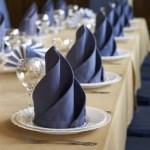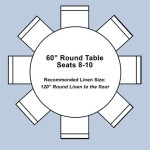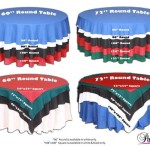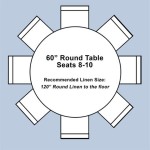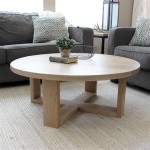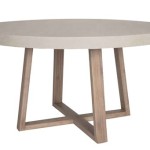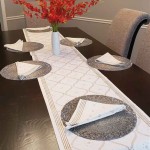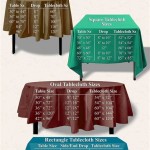How To Decorate With Table Runners And Placemats
Table runners and placemats are versatile decorative elements that can significantly enhance the aesthetic appeal of a dining table or any flat surface. They offer a practical way to protect furniture from scratches and spills while simultaneously adding color, texture, and visual interest to a space. Choosing the right runners and placemats involves considering various factors, including table size, shape, material, color palette, and the overall style of the room. Employing these decorative pieces effectively can transform a mundane setting into an inviting and stylish environment.
The function of table runners and placemats extends beyond pure decoration. They serve as anchors for place settings, defining each individual’s dining space and contributing to a sense of order and organization. When used correctly, they can elevate the dining experience, making it feel more special and considered. This article will provide a comprehensive guide on how to select and utilize table runners and placemats to create visually appealing and functional table settings.
Understanding the Different Types of Table Runners
Table runners are long, narrow pieces of fabric that are typically centered on a table, running lengthwise or crosswise. They come in a wide variety of materials, sizes, and designs, each offering a different aesthetic and functionality. The choice of material significantly impacts the overall look and feel of the table setting. Understanding these different types is crucial for selecting the right runner for a particular occasion and style.
Material Choices:
Common materials for table runners include cotton, linen, silk, burlap, velvet, and synthetic fabrics. Cotton runners are typically affordable, durable, and easy to care for, making them ideal for everyday use. Linen runners offer a more sophisticated and textured look, but may require more careful laundering. Silk runners exude elegance and are suitable for formal occasions, but are often more delicate and require professional cleaning. Burlap runners provide a rustic and natural aesthetic, perfect for casual or farmhouse-style settings. Velvet runners add a touch of luxury and warmth, especially during the colder months. Synthetic fabrics, such as polyester blends, offer durability and stain resistance, making them a practical choice for households with children or frequent entertaining.Size and Shape Considerations:
The ideal length of a table runner depends on the size and shape of the table. A general rule is to allow the runner to overhang by at least 6-12 inches on each end. For a more formal look, the overhang can be longer. The width of the runner should be proportional to the width of the table. A narrow runner on a wide table may look insignificant, while a wide runner on a narrow table may appear overwhelming. Table runners are available in various widths, typically ranging from 12 to 18 inches. In terms of shape, most table runners are rectangular, but circular or oval runners can also be used on round or oval tables.Design and Pattern Options:
Table runners offer a vast array of design and pattern options. Solid-colored runners provide a clean and understated look, allowing the tableware and other decorative elements to take center stage. Patterned runners can add visual interest and personality to the table setting. Common patterns include floral prints, geometric designs, stripes, and seasonal motifs. When choosing a patterned runner, it is important to consider the existing color scheme and décor of the room. A runner with complementary colors and a pattern that harmonizes with the overall style will create a cohesive and visually appealing look.Selecting the Right Placemats for Your Needs
Placemats are individual place settings that protect the table from spills and scratches while adding a decorative touch. They are typically smaller than table runners and are placed directly under each diner's plate and cutlery. Like table runners, placemats come in a variety of materials, shapes, and designs, each offering a different aesthetic and functionality. Choosing the right placemats involves considering the style of the table, the type of meal being served, and the overall ambiance one wishes to create.
Material Choices:
Placemats are available in a wide range of materials, including fabric, vinyl, cork, bamboo, rattan, and even metal. Fabric placemats, such as cotton, linen, and polyester blends, offer a soft and comfortable feel and are available in a wide variety of colors and patterns. Vinyl placemats are durable, easy to clean, and stain-resistant, making them ideal for everyday use and households with children. Cork placemats are heat-resistant and provide a natural and rustic look. Bamboo placemats offer a similar aesthetic but are often more durable and water-resistant. Rattan placemats add texture and warmth to the table setting, perfect for casual or bohemian-style décor. Metal placemats offer a modern and sleek look and are often heat-resistant, but they can be noisy and may scratch the table if not properly cushioned.Shape and Size Considerations:
Placemats come in various shapes, including rectangular, square, round, and oval. The shape of the placemat should complement the shape of the table and the dinnerware. Rectangular placemats are the most common and versatile option, suitable for most table shapes and settings. Round placemats can soften the angular lines of a rectangular table and are often used with round dinnerware. Square placemats offer a more modern and geometric look. The size of the placemat should be large enough to accommodate a dinner plate, cutlery, and a glass, without overcrowding the table. A standard size for rectangular placemats is 12 x 18 inches, while round placemats typically have a diameter of 15 inches.Color and Design Coordination:
When selecting placemats, it is important to consider the color scheme and design of the table setting and the overall room. Placemats can be used to complement or contrast with the tablecloth, dinnerware, and other decorative elements. Solid-colored placemats provide a clean and classic look, while patterned placemats can add visual interest and personality. When using patterned placemats, it is important to ensure that the pattern harmonizes with the other elements on the table. For example, floral placemats can be paired with solid-colored dinnerware and a neutral tablecloth for a cohesive and elegant look. Alternatively, contrasting colors can be used to create a bold and dramatic effect. For instance, bright red placemats can be paired with a white tablecloth and black dinnerware for a modern and striking table setting.Creating Harmonious Table Settings: Combining Runners and Placemats
Combining table runners and placemats can create a layered and visually appealing table setting. The key to success lies in understanding how to coordinate the different elements to achieve a harmonious and balanced look. Careful consideration should be given to the materials, colors, patterns, and sizes of both the runner and the placemats to ensure that they complement each other and enhance the overall aesthetic of the table.
Complementary Colors and Patterns:
One approach to combining runners and placemats is to use complementary colors and patterns. Complementary colors are colors that are opposite each other on the color wheel, such as blue and orange, or green and red. Using complementary colors can create a vibrant and visually stimulating table setting. For example, a blue table runner can be paired with orange placemats for a bold and striking effect. When using patterned runners and placemats, it is important to choose patterns that complement each other. For instance, a floral table runner can be paired with striped placemats, provided that the colors and scale of the patterns are harmonious. Avoid using overly busy or clashing patterns, as this can create a chaotic and overwhelming look.Contrasting Textures and Materials:
Another effective strategy is to combine runners and placemats with contrasting textures and materials. This can add depth and interest to the table setting. For example, a linen table runner can be paired with rattan placemats for a rustic and textural look. Alternatively, a silk table runner can be combined with metal placemats for a more modern and sophisticated look. Experimenting with different combinations of textures and materials can help to create a unique and personalized table setting.Layering Techniques:
Layering is a key element in creating a visually appealing table setting. One common layering technique is to place the placemats on top of the table runner. This can help to define each individual place setting and create a sense of order and organization. Another technique is to use a tablecloth as a base layer, followed by a table runner, and then placemats. This creates a more formal and layered look. When layering runners and placemats, it is important to ensure that the sizes and proportions are appropriate. A runner that is too wide or too long can overwhelm the placemats, while a runner that is too narrow or too short may look insignificant. Similarly, placemats that are too large can crowd the table, while placemats that are too small may look out of place.In conclusion, through thoughtful selection and arrangement, table runners and placemats add both function and style to a table setting. The careful coordination of material, color, and pattern transforms a dining space into something more elegant and inviting.

5 Ways To Decorate A Table With Runner Pottery Barn

5 Ways To Decorate A Table With Runner Pottery Barn

Set The Table With Rich Grays Pearls And Champagne Colors Mayamam Weavers Handwoven Dining Room Runner Entertaining Settings

How To Use Table Runners At Home House Garden

How To Decorate With Table Runners

How To Use Table Runners And Placemats Storables

Table Runners And Placemats Guide Crate Barrel Embroidered Runner Holiday Cloth

Table Runners Add Color Style To Rooms Supreme Accents

Hangnuo 13x83inch Table Runner And 4 Set Placemats With Sequined Rhinestone Elegant Decoration For Wedding Thanksgiving Black Cenas En Casa Decoración De Mesas Navideñas Barras Café
How To Set A Table Homegoods Photoshoot Reveal Four Generations One Roof Blog
Related Posts

